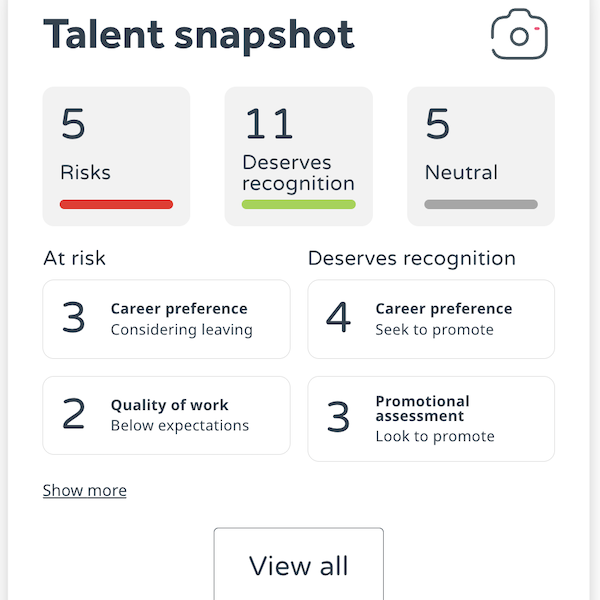Whether your employees are back in the office or still working from home, understanding how to improve employee retention should be a top priority if you want to create efficient, productive and engaged teams.
Following the global pandemic and being faced with such an uncertain economic climate, the last thing your business needs is to lose its top talent. If business leaders and HR managers are considering a recruitment freeze, they will also need to revisit retention strategies if they want to successfully navigate through these turbulent times.
So, how does your employee retention strategy stand up? Our mini guide tells you all you need to know to make sure it does.
Why you need to revisit your employee retention strategy now

With such a huge shift in the way we work, all businesses should be reviewing how staff are supported. In chaotic times, it is so easy to lose sight of the fundamentals, but without great people, any business is far less likely to succeed.
Now is the time to think about how you can retain your valuable employees.
What is an employee retention strategy?
An employee retention strategy refers to the objectives required to keep staff happy in their jobs and deter them from seeking employment elsewhere. Ultimately, it’s all about building a talented workforce and reducing staff turnover.
But retaining staff isn’t as straightforward as it seems.
It’s obvious that employees need to feel happy and fulfilled in their jobs. Unhappy employees are less productive and much more likely to leave.
There are plenty of things employers can do to keep employees focused, motivated and productive, and prevent them from leaving.
The challenge for employers is to meet the expectations of employees, while still keeping the company’s business objectives on track. Employers must invest in employees, but they also need to see a return. Up to 42 percent of employees feel their job satisfaction hinges on having opportunities for career development.
42% of employees say job satisfaction is hinged on career development opportunities
So, what does an improved employee retention strategy look like?
An employee retention strategy covers all of the policies required to balance people’s needs with company goals. These include:
- Competitive renumeration and perks
- Training and development
- Opportunities for personal growth
- Recognition and rewards
- A culture promoting work-life balance
- Regular communication and feedback
- Fairness and transparency
- Accountability and responsibility
- A culture of respect
Why employee retention is important
High staff turnover is damaging and it’s expensive. Research carried out by Oxford Economics found that it takes recently hired professional workers 28 weeks to reach optimum productivity – which has an attached cost of £25,200 per employee. while managerial roles can cost a business between £20,000 and £30,000 in recruiting and training expenses. There are also implications for efficiency throughout the team while a new recruit learns the ropes and gets up to speed.
Replacing the average employee costs SMEs £25,200
A steady stream of leavers impacts the morale of the team left behind. When employees leave, remaining staff are often expected to take up the slack until a replacement can be found. It’s a situation where resentment can easily build.
Losing experienced staff also impacts knowledge and client relationships. It can have a seriously detrimental impact on client retention and business success. Even worse is the possibility that your experienced employee has joined a competitor, giving them the edge.
If people are leaving your business in droves, you may want to ask yourself why? With recruitment platforms like Glassdoor on the rise, employers can no longer hide from the outside world when it comes to culture and how they treat their employees.
How to retain employees during a crisis
Better pay and a more impressive job title are important. Nearly nine in 10 companies (88 percent) view incentive compensation and bonuses as key to retaining employees in the next five years.
88% of companies view compensation and bonuses as key to retaining employees
But these aren’t the only things that will buy employee loyalty. There are a whole host of subtle factors that can make an employee decide to head for pastures new.
Even during difficult times, there are ways employers can improve employee retention.
- Give employees opportunities and incentives
- Empower staff with training
- Ensure workers maintain a good work-life balance, including when they work from home
- Listen to what employees need
Importantly, keeping your teams’ sense of camaraderie is vital, and especially difficult during the current circumstances with staff perhaps furloughed or working remotely. Communication and openness are key.
Organisations that survive curve balls usually do so because they have a pretty good team of people on board. It’s an old adage – talent underpins success. How do businesses survive recessions? They innovate, regroup and grow, despite the climate. Their success is a reflection of the people they have in their team.
Staff retention is usually a good measure of the kind of company you run – high staff turnover usually says you’re not a very good employer to work for. What kind of employer are you? If you consider your employees to be your greatest asset, then you are probably on the right track.
3 ways to reduce turnover
Run an employee survey now, before it’s too late
If you run an annual employee survey at the beginning or end of the year then you are entirely skipping the mid-year point where you can actually do something about the people data you collect. But not just any old survey. You need an agile employee survey tool that truly engages with employees. That goes beyond the obvious and uncovers subconscious factors that could be impacting employee morale. One that then delivers the people data in a way that is intuitive and enables you to then take action fast, so employees feel listened to and you are able to address any issues.
We may be biased, but there aren’t many tools out there like our employee engagement software. Empowered with psychological intelligence and supported by intuitive reporting, team manager and individual support. With predictive retention heatmaps you can quickly and easily identify specific employees or teams who are most at risk of attrition as well as finding out exactly how to help.
Check out The guide to employee engagement: For happy and productive people.
Arrange team building activities
To help engage employees beginning to consider moving on, why not have arrange some interdepartmental team building days. There are plenty of corporate team building group activities that can be affordable and accessible. Departments could assemble a Crystal Maze team, and enjoy some adventure activities like rally kart racing.
If an offsite outing isn’t in the budget then you could setup a ‘bring your own game’ afternoon in the office or run Friday Hackathons when employees can help redesign processes or implement innovative solutions. A clever way to help them reconnect to the business and boost efficiency in the process.
Engage employees with development opportunities
If business priorities have been getting in the way of career development pathways for your employees, now is the time to address it. Encourage managers to proactively map out those career pathways and actually implement the next steps. Whether that is beginning the process of enrolment on internal or external training programmes or setting up mentorship partnerships with senior members of the team.
If an employee is thinking of leaving then they are struggling to see a future with your business. Help them build a picture of the future to boost their morale and revive a sense of purpose. Even if an employee thinks their main reason for leaving is not getting a pay rise the real reason often goes deeper than that. Based on our surveys across a broad spectrum of clients we found that employees want to:
- Feel valued by their employer
- Understand their role within the business
- Nurture a sense of purpose
Help them do that! If they had all of those the chances are they wouldn’t move on and feel a stronger sense of loyalty and connection to the business. Take the extra time now to make changes that prove you are listening and those employee turnover figures won’t set you off on the wrong foot post-pandemic. Want to dive deeper? Download our white paper. 👇




